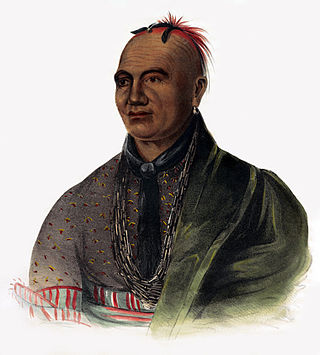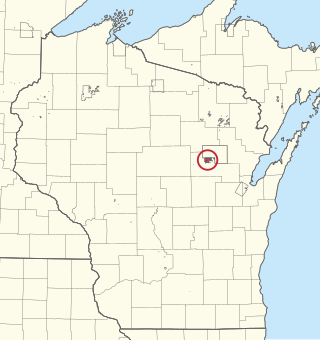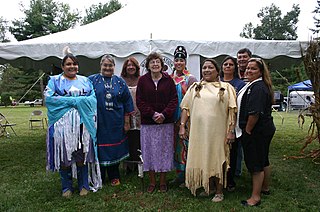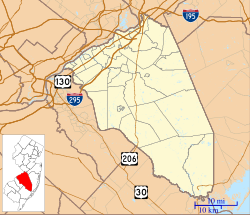
The Mohican are an Eastern Algonquian Native American tribe that historically spoke an Algonquian language. As part of the Eastern Algonquian family of tribes, they are related to the neighboring Lenape, whose indigenous territory was to the south as far as the Atlantic coast. The Mohican lived in the upper tidal Hudson River Valley, including the confluence of the Mohawk River and into western New England centered on the upper Housatonic River watershed. After 1680, due to conflicts with the powerful Mohawk to the west during the Beaver Wars, many were driven southeastward across the present-day Massachusetts western border and the Taconic Mountains to Berkshire County around Stockbridge, Massachusetts.

Shamong Township is a township in Burlington County, in the U.S. state of New Jersey. As of the 2020 United States census, the township's population was 6,460, a decrease of 30 (−0.5%) from the 2010 census count of 6,490, which in turn reflected an increase of 28 (+0.4%) from the 6,462 counted in the 2000 census. The township, and all of Burlington County, is a part of the Philadelphia-Reading-Camden combined statistical area and the Delaware Valley.

The Lenape, also called the Lenni Lenape and Delaware people, are an indigenous people of the Northeastern Woodlands, who live in the United States and Canada. The Lenape's historical territory included present-day northeastern Delaware, all of New Jersey, the eastern Pennsylvania regions of the Lehigh Valley and Northeastern Pennsylvania, New York Bay and western Long Island, and the lower Hudson Valley.
The Ramapough Mountain Indians, also known as the Ramapough Lenape Nation or Ramapough Lunaape Munsee Delaware Nation, are a group of approximately 5,000 people living around the Ramapo Mountains of Bergen and Passaic counties in northern New Jersey and Rockland County in southern New York, about 25 miles (40 km) from New York City. They were recognized in 1980 by the state of New Jersey as the Ramapough Lenape Nation but are not federally recognized. Their tribal office is located on Stag Hill Road on Houvenkopf Mountain in Mahwah, New Jersey. Since January 2007, the chief of the Ramapough Lenape Nation has been Dwaine Perry.

Lenapehoking is widely translated as 'homelands of the Lenape', which in the 16th and 17th centuries, ranged along the Eastern seaboard from western Connecticut to Delaware, and encompassed the territory adjacent to the Delaware and lower Hudson river valleys, and the territory between them.

The Delaware languages, also known as the Lenape languages, are Munsee and Unami, two closely related languages of the Eastern Algonquian subgroup of the Algonquian language family. Munsee and Unami were spoken aboriginally by the Lenape people in the vicinity of the modern New York City area in the United States, including western Long Island, Manhattan Island, Staten Island, as well as adjacent areas on the mainland: southeastern New York State, eastern Pennsylvania, New Jersey, Connecticut, Maryland, and Delaware.

Indigenous peoples of the Northeastern Woodlands include Native American tribes and First Nation bands residing in or originating from a cultural area encompassing the northeastern and Midwest United States and southeastern Canada. It is part of a broader grouping known as the Eastern Woodlands. The Northeastern Woodlands is divided into three major areas: the Coastal, Saint Lawrence Lowlands, and Great Lakes-Riverine zones.

The Christian Munsee are a group of Lenape, an Indigenous people in the United States, that primarily speak Munsee and have converted to Christianity, following the teachings of Moravian missionaries. The Christian Munsee are also known as the Moravian Munsee or the Moravian Indians, the Moravian Christian Indians or, in context, simply the Christian Indians. As the Moravian Church transferred some of their missions to other Christian denominations, such as the Methodists, Christian Munsee today belong to the Moravian Church, Methodist Church, United Church of Canada, among other Christian denominations.
The Brothertown Indians, located in Wisconsin, are a Native American tribe formed in the late 18th century from communities of so-called "praying Indians", descended from Christianized Pequot, Narragansett, Montauk, Tunxis, Niantic, and Mohegan (Algonquian-speaking) tribes of southern New England and eastern Long Island, New York. In the 1780s after the American Revolutionary War, they migrated from New England into New York state, where they accepted land from the Iroquois Oneida Nation in Oneida County.

The Unalachtigo were a purported division of the Lenape, a Native American tribe whose homeland Lenapehoking was in what is today the Northeastern United States. They were part of the Forks Indians.
The Nanticoke Lenni-Lenape people are a tribal confederation of Nanticoke of the Delmarva Peninsula and the Lenape of southern New Jersey and northern Delaware. They are recognized by the state of New Jersey, having reorganized and maintained elected governments since the 1970s. They have not yet achieved federal recognition.

The Wappinger were an Eastern Algonquian Munsee-speaking Native American people from what is now southern New York and western Connecticut.

The Stockbridge–Munsee Community also known as the Mohican Nation Stockbridge–Munsee Band is a federally recognized Native American tribe formed in the late eighteenth century from communities of so-called "praying Indians", descended from Christianized members of two distinct groups: Mohicans and Wappinger from the praying town of Stockbridge, Massachusetts, and Munsees, from the area where present-day New York, Pennsylvania and New Jersey meet. Their land-base, the Stockbridge–Munsee Indian Reservation, consists of a checkerboard of 24.03 square miles (62.2 km2) in the towns of Bartelme and Red Springs in Shawano County, Wisconsin. Among their enterprises is the North Star Mohican Resort and Casino.
Mohican is a language of the Eastern Algonquian subgroup of the Algonquian language family, itself a member of the Algic language family. It was spoken in the territory of present-day eastern New York state and Vermont by the Mohican people but is believed to have gone extinct for seven decades. However, since the late 2010s, the language is being revived, with adults learning the language, and children being raised having Mohican as their first language.

The Esopus was a tribe of Lenape (Delaware) Native Americans who were native to the Catskill Mountains of what is now Upstate New York. Their lands included modern-day Ulster and Sullivan counties.

Morristown Green, most commonly referred to as the Green, is a historical park located in the center of Morristown, New Jersey, United States. It has an area of two and a half acres and has in the past served as a military base, a militia training ground, and an area for public executions. It is now a public park in which many community events are held. It was added to the National Register of Historic Places, listed as a contributing property of the Morristown District, on October 30, 1973.
The Loantaka Brook Reservation is a nature reserve and public park in the American state of New Jersey in Morris County. It consists of five miles of nature trails for jogging, hiking, and biking. Seaton Hackney Stables, owned and operated by the Morris County Park Commission, offers horseback riding at an adjacent property with trail riding along a long and narrow corridor near the Loantaka Brook. It has four distinct areas including the South Street recreation facilities, the Seaton Hackney Stables, the Loantaka Brook area at Kitchell Road, and the Loantaka Way Trail.

The Munsee are a subtribe and one of the three divisions of the Lenape. Historically, they lived along the upper portion of the Delaware River, the Minisink, and the adjacent country in New York, New Jersey, and Pennsylvania. They were prominent in the early history of New York and New Jersey, being among the first Indigenous peoples of that region to encounter European colonizers.
Coaxen Indian Village or Weekpink was named after Coaxen, the name of a local band of Lenape located in Burlington County, New Jersey, along the South Branch of the Rancocas Creek. It is also the name of both a nearby stream and one of two villages known during the historic period, residence of this native group, the other being Weekpink. Weekpink is also the name of a small run of water that empties into the South Branch of the Rancocas, and is also located within the historic bounds of the Coaxen Indian settlement. This settlement, and both streams, are now located in Southampton Township, New Jersey.

Washington Valley is an unincorporated community in the Whippany River valley within Morris Township in Morris County, New Jersey.















